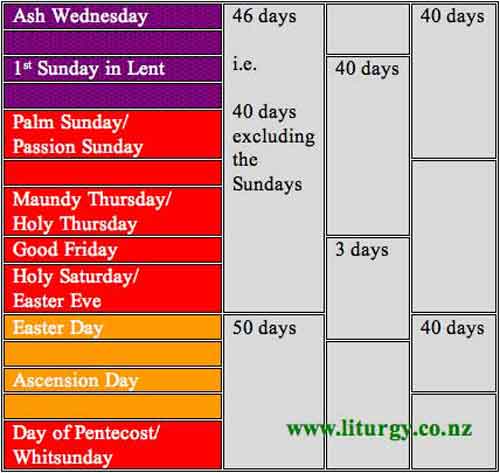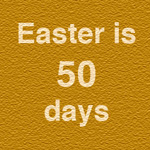
The Great Fifty Days of Eastertide form a single festival period in which the tone of joy created at the Easter Vigil is sustained through the following seven weeks, and the Church celebrates the gloriously risen Christ:
Triumphant in his glory now,
his sceptre ruleth all,
earth, heaven and hell before him bow,
and at his footstool fall.
(Fulbert of Chartres)Early Christians gave the name Pentecost to this whole fifty-day span of rejoicing, which Tertullian calls ‘this most joyful period’ (laetissimum spatium). It is sometimes also called ‘Great Sunday’. In those places where the custom of lighting the Easter Candle at the beginning of Easter is followed, the lit Candle stands prominently in church for all the Eastertide services. The Alleluia appears frequently in liturgical speech and song; Morning Prayer begins with the traditional collection of Pauline texts known as the Easter Anthems, and white or gold vestments and decorations emphasize the joy and brightness of the season.
On the fortieth day there has from the late fourth century been a particular celebration of Christ’s ascension. He commissions his disciples to continue his work, he promises the gift of the Holy Spirit, and then he is no longer among them in the flesh. The ascension is therefore closely connected with the theme of mission. The arrival of the promised gift of the Holy Spirit on the day of Pentecost completes and crowns the Easter Festival.
Church of England Common Worship
Easter Season
(From Easter day through to the Day of Pentecost)
Renewal of worship has rediscovered the value and significance of the Easter Season. Easter is not just “Easter Day,” it is the fifty days from Easter Day until the Day of Pentecost. During this season, Sundays might be better named “of Easter” rather than “after Easter” (“The Third Sunday after Easter,” for example, is better termed “The Fourth Sunday of Easter”).
Celebrating Eucharist (freely available on this site)
Easter, Ascension, and Pentecost do not form three seasons. The Easter season celebrates the three dimensions of the resurrection, ascension, and the sending of the Spirit. Ascension material is appropriately used as Ascension Day approaches. Pentecost material is appropriate from Ascension Day to the Day of Pentecost. Easter threads, of course, remain suitable up to and including the Day of Pentecost.
These fifty days, a seventh of the year, form our great “Sunday” of the year. “Alleluia! Christ is risen. He is risen indeed. Alleluia!” forms the greeting in every service during Eastertide. Similarly “Alleluia! Alleluia!” is added to the Dismissal and the people’s response (these are equivalent to the “Alleluia” added at the beginning and end of the Daily Services). These help to give these celebrations a distinctive festal feel.
The Paschal Candle is lit at every service up to and including the Day of Pentecost. “Glory to God in the highest” may be used daily from Easter Day through the Day of Pentecost. Alternatively, some communities use it daily for the first week of Easter. Other appropriate Songs of Praise are given below.
We in the southern hemisphere could make far more use of a Service of Light throughout the fifty days of Easter. Daily, or on certain days, people might gather in church in the evening, to light the Paschal Candle and sing the (at least sixteen centuries old) “Hail gladdening Light” (Phos Hilaron page 175) or another hymn. Thanksgiving for light may follow, incense may be used (Ps 141:2), and parts of Night Prayer, Evening Worship, or the Daily Services may be used. Such a Service of Light, appropriately simplified, can form a very attractive focus for family prayer or prayer in a housegroup.
A Vigil service on the eve of the Day of Pentecost could focus around such a Service of Light. The Day of Pentecost concludes the Easter Season. Pentecost is our church’s winter festival when we celebrate the sweeping of the Spirit of God over the darkness and over the face of the waters.
The Jewish Pentecost was a single feastday celebrating harvest and commemorating the covenant. In the early church, however, the Christian Pentecost was not merely the “fiftieth day,” but the word “Pentecost” often referred to the whole period of fifty days which began on Easter Day. This stress is being recovered. Now once more Eastertide is the “Season of Pentecost.” The Day of Pentecost concludes the Pentecost season rather than beginning it.
Just as Sunday is the first and the eighth day, so the “great Sunday” of the fifty days of Eastertide/Pentecost begins with the day of the resurrection and continues through eight Sundays, an octave of Sundays, a “week of weeks.” It has been suggested that the English expression “Whitsunday” derives from the French huit (eight), Pentecost being le huitième dimanche, the eighth Sunday of Easter.
In the Fourth Gospel the risen Christ imparts the gift of the Spirit on the evening of Easter Day (John 20:19-23). The Spirit is the gift of the risen Christ. And so in the Easter Season, this “Pentecost Season,” (particularly in the Three Year Series) we listen to the farewell discourses, with their promise of the coming Advocate, as words to us from the risen Christ.
Easter is 50 Days – click “going”
Many people like, from time to time, to add a badge to their website or blog. Here is one for the Easter Season:

The HTML for adding the above badge to your blog or website is:
<a href=”http://www.liturgy.co.nz” title=”Easter”><img alt=”Liturgy” src=”http://www.liturgy.co.nz/images/easterbadge.jpg” /></a>
Further images

The HTML for adding this badge to your blog or website is:
<a href=”http://www.liturgy.co.nz” title=”Easter”><img src=”http://www.liturgy.co.nz/images/easter-is-living-outside-the-box.jpg” alt=”liturgy” border=0 width=294 height=362></a>

The HTML for adding this badge to your blog or website is:
<a href=”http://www.liturgy.co.nz” title=”Easter”><img src=”http://www.liturgy.co.nz/images/easter-is-living-outside-the-box-150×150.jpg” alt=”liturgy” border=0 width=150 height=150></a>
If you appreciated this post, consider liking the liturgy facebook page, using the RSS feed, and/or signing up for a not-very-often email, …
Instagram’s @liturgy is the new venture – if you are on Instagram, please follow @liturgy.



